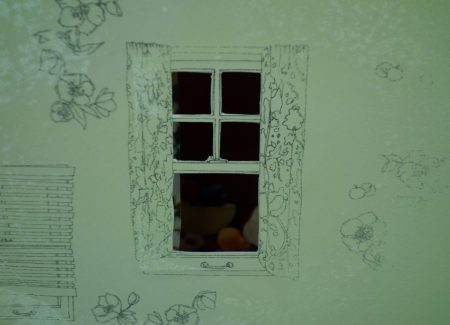JTF (just the facts): A paired show of works by Ryan Oskin and Kate Stone, on view against white walls in the single room gallery space.
Ryan Oskin:
- 1 UV curable ink on Colorplast, Plexiglas, and Sintra, on wood shelf, 2018, 29x24x3 inches
- 1 UV curable ink on Colorplast and Sintra, 2019, 30x19x1 inches
- 1 UV curable ink on Colorplast and aluminum Dibond, 2018, 36x24x1 inches
- 1 double sided UV curable ink on aluminum, 2018, 47×30 inches
- 1 UV curable ink on aluminum with wood platform, 2017-2018, 72x24x24 inches
Kate Stone:
- 1 two-channel video installation, drywall, photographs, wood, latex paint, LEDs, carpet, 2019, 108x60x96 inches
(Installation and detail shots below.)
Comments/Context: Half a dozen years ago, or perhaps a generation or two in Internet time, many photographers out on the cutting edge of the medium were busy exploring how new printing technologies could allow photographs to become more three dimensional. At that time, it seemed like hardly a week would go by before yet another show would open with photographs printed on the next most unimaginable substrate. And while the image/object dichotomy of the photographic print has been inherent to the medium since its invention and was boldly investigated by the photococeptualists of the 1960s and 1070s, it felt like we were onto something refreshingly new – a way that photographic imagery could be a freed from its traditional constraints and allowed to take shape in other forms.
In the short years since that time, we have seen a natural consolidation, where the core aesthetic ideas enabled by the new printing options have been refined and reinterpreted enough times to the point that the wave of frenzied experimentation has settled down, and been replaced by a next generation of more controlled adoption. The artists who are continuing to explore this terrain of materiality are not chasing the next hot thing, but are instead using the now maturing approaches to thoughtfully enhance and extend their own lines of thinking. We have moved from “cool because it’s printed on something unexpected” to printing innovation tamed by larger artistic ideas.
This show pairs two artists who are unpacking photography and its relationship to constructed space, and the ability to integrate more physicality into their works is central to both. Ryan Oskin’s works start with photographs of architectural details, from sleek skyscraper windows to rough two-by-four interior framing, which he then builds out into layered collages with intentional three dimensionality. Several of the source images are printed on thick corrugated paper (like the kind used for political yard signs), so when the images are placed on top of each other, they create noticeable thickness and depth. This is most effective in his work “Ground Floor”, where two views of staircases are interleaved and set against a brick backdrop. What is only really visible in person (and is shown in the detail image above) is that the alternating stripes of imagery are pushed up into triangled points, the whole surface become its own stair-stepped progression. Given the subject matter of the pictures, the work is satisfyingly tense, the iterations of construction literally piling on top of each other.
Two other works by Oskin leave the walls behind for the airiness of the gallery’s interior space. “Artifact” places photographs of balustrades on both sides of an aluminum substrate, the images of shaped forms curved into a sculptural saw toothed spiral. “Double Skin” also employs a front and back approach, sandwiching two views of an ornate grill atop chain link fence and corrugated metal (one view slightly bluer than the other) on one panel, creating a dangling form that hangs and spins in space. Both works take flat architectural elements and give them an echo of three dimensionality that mimics their original form.
Kate Stone’s installation doesn’t reveal its secrets quite so easily. Built into a corner of the gallery, its structure is rough and ready, with exposed two-by-fours and jagged painted sheetrock redefining the proportions of the area in which the work sits. A tight hallway-like space is created in the “back” of the work, and once we are inside this transitional nook, small windows (with faint drawing/stenciling around them) and cracks reveal imagery to be seen. Inside the windows, Stone has constructed domestic still lifes of fruit and furniture, the diminutive scissored images of images creating a layered diorama or doll house effect. Inside the cracks, stop motion videos of more elaborate interiors run, with a headphone soundtrack that adds the sounds of wind, slamming doors, passing rainstorms, and other creaks and whooshes. There are no people (or actors) in Stone’s jittering setups, so we voyeuristically watch (you have to bend down to peer in the cracks) as the empty setting jumps and breathes, as if alive with invisible urges and memories. As an integrated experience, the installation gives Stone’s photographic setups a stronger sense of scale and physical presence, animating the constructions and giving them more eerie claustrophobic resonance.
Both of these approaches feel appropriately provisional, like steps on a path with many more ahead. But in methodically taking apart and reassembling the photographic idea of spatial construction, Oskin and Stone are reaching for (and building) new artistic white space. What is exciting is that the physicality they are exploring seems less random and bolted on than before, its material nuances better envisioned and executed. They’re quietly altering the edge definitions of photographic space, and we should keep watching.
Collector’s POV: The works in this show are priced as follows. Ryan Oskin’s works range from $1000 to $2500, while Kate Stone’s installation is POR. Neither artist has any secondary market history at this point, so gallery retail remains the best option for those collectors interested in following up.














